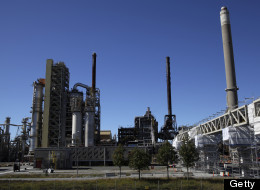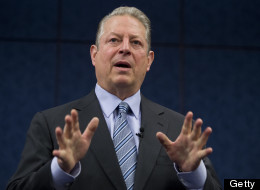
Inside the offices of MIT's Energy Initiative, a campus-wide program with the ambitious goal of helping to "transform the global energy system," Howard J. Herzog, a senior research engineer, pulled out a fresh yellow legal pad and began sketching a line graph. He was responding to a straightforward question: In a world so addicted to fossil fuels, and yet so threatened by the planet-warming carbon dioxide they produce, why has one seemingly elegant and elementary solution -- blocking that CO2 from entering the atmosphere in the first place -- proved so elusive?
It's a question Herzog has grappled with for some 25 years. The essential know-how for collecting carbon dioxide out of industrial exhaust streams dates back at least to the 1930s, after all. Yet, despite billions in government subsidies and a widely held view among many energy experts that climate change can't truly be addressed without it, carbon capture and storage technology, or CCS as it is known, has struggled mightily to get off the ground.
Herzog, who has headed MIT's Carbon Capture and Sequestration Technologies Program since 1989, says that's a policy failure, not a technological one. On his legal pad, he draws a vertical axis, which he says represents the cost of emitting carbon dioxide into the air. Extending along his horizontal axis are increasing volumes of the gas that might be captured instead. As he drags his pencil on a curve upward and outward from the axes' origin, the plight of carbon capture and storage -- and really, the plight of any clean-energy innovation -- is laid bare: The more CO2 you want to capture, Herzog explains, the higher the market price of emitting the gas has to be.
"At the moment," Herzog says, "the cost of emitting carbon, for all practical purposes, is zero."
The economic implications of that are straightforward: Government subsidies and other small-bore incentives may provide some marginal nudging, but it remains far, far cheaper to keep pumping carbon dioxide into the atmosphere than to develop, test and nurture the sort of gargantuan capture-and-storage systems that might put a real dent in the global warming problem.
Yet, according to many energy experts, the costs of not developing technologies like CCS will continue to rise as the climate clock keeps ticking. Solar and wind power, they say, simply cannot be deployed quickly and widely enough to tackle climate change on their own. That leaves just two other possibilities, Herzog suggests: A rapid expansion of nuclear power, which has a low carbon footprint, but a dubious reputation, or rapid deployment of industrial-scale CCS.
The Paris-based International Energy Agency has estimated that in the absence of CCS, the cost of addressing climate change may be as much as 70 percent higher by mid-century. And the Intergovernmental Panel on Climate Change, the transnational body charged with assessing the scientific, technical and socioeconomic dimensions of the global warming problem and its potential solutions, considers CCS an essential part of any effort to de-carbonize the planet's economies over the next century.
Not everyone buys these metrics, and many climate and clean-energy advocates routinely dismiss or downplay the potential role of CCS. They consider it hopelessly expensive, dangerously untested, and, under the rubric of "clean coal," little more than an empty slogan embraced by an industry angling to preserve its grip on power production -- or by lawmakers keen to appear friendly to the very deep-pocketed peddlers of fossil fuels.
Tens of thousands of miles of new pipelines and other infrastructure would be needed to move the CO2 around, these advocates argue. And while there are some potential markets for the gas -- the food and beverage industry, for instance (think bubbly soda), or even by fossil fuel drillers, who have long injected CO2 into waning underground wells to coax out more crude -- commercial demand for captured CO2 will remain minuscule compared with the tens of billions of metric tons of carbon dioxide we currently exhale into the ether every year. All of that would need to find safe and permanent storage underground -- itself a worrying prospect for environmentalists.

"I think it's at least in part a way for politicians to show they're not anti-coal," says climate activist and author Bill McKibben. "But I've never met anyone who thinks [CCS] will actually play a serious part in dealing with our crisis. You can do it -- but so expensively it makes no sense."
Herzog and others don't dispute that CCS is costly, but they argue that every other potential solution to the gathering climate crisis is equally if not more so. They also suggest that much of the skepticism surrounding CCS is unfounded, given the long history of capturing the stuff and a robust body of geological research and evidence suggesting that CO2 can, in all likelihood, be safely and securely stored underground.
But Herzog noted that until it becomes vastly more expensive to simply puff the stuff skyward -- through a cap-and-trade scheme or a carbon tax, for instance, or tough government-enforced emissions limits -- the technologies needed to tackle global warming will always remain out of reach.
"You have to remember," he says, "there's really no such thing as a free lunch."
A MASSIVE PROBLEM
The scope of the challenge is immense. Carbon dioxide emissions come from lots of sources -- cars and trucks, for example, or residential and commercial buildings. But heavy industry and electricity production, both of which rely to a significant extent on the burning of coal, natural gas or oil to do what they do, make for a highly polluting combination. According to the Energy Information Administration, the world currently spews a little less than 35 billion metric tons of carbon dioxide gas into the atmosphere every year. About a quarter of that comes from burning coal, oil and natural gas for electricity and heat. Another 20 percent arises from large-scale industrial activity, including chemical, metal and mineral processing.
Together, heavy industry, along with electricity and heat production -- the prime targets for carbon capture and storage technology -- account for roughly half of all global greenhouse gas emissions.
Planet-warming pollution is beginning to plateau in developed economies like the U.S. -- mostly because of slackening demand and the current low cost, compared with coal, of marginally cleaner natural gas as an electricity fuel. But rich nations remain, in aggregate, the planet's largest polluters. They have been so for the better part of two centuries.

Meanwhile, China and India and other booming parts of the developing world are inclined -- just as the rich world long has been -- to gorge on the cheapest and most readily available energy sources to keep their economies growing and their standards of living rising. They are busy building hundreds of new coal- and gas-fired power plants, and are poised to keep nudging global warming emissions rapidly upward over the century to come.
By some estimates, global energy-related carbon dioxide emissions are expected to reach 45 billion metric tons annually by 2040, according to data published by the U.S. Energy Information Administration last month. For some perspective, that's approaching 200 times the amount of CO2 naturally released by all of the planet's land-based and undersea volcanoes combined in any given year.
Given all of this, atmospheric concentrations of carbon dioxide have recently passed 400 parts per million, a milestone that many scientists consider worrying. Such concentrations of CO2 have not been seen on Earth for millions of years, and the rate at which these levels have risen over the last several decades is almost unprecedented in recorded history. Given the planet's continued reliance on fossil fuels, there is currently no indication that this upward trend will stop anytime soon. And while scientists remain divided over the precise character and timing of global warming's finer impacts, the odds of more severe, destructive and costly weather patterns increases inexorably with the rising tides of CO2.
"We are a society that has inadvertently chosen the double-black diamond run without having learned to ski first," says Dr. Gavin Schmidt, a climatologist and climate modeler at NASA's Goddard Institute for Space Studies, referring to the 400 ppm milestone. "It will be a bumpy ride."
Tackling the problem can be achieved by any number of means. Some observers, assuming that humanity won't soon abandon the convenience and energy density of fossil fuels, put their faith in geoengineering -- a catch-all term for sci-fi solutions like seeding clouds or oceans with reflective particles to cool the entire planet. But these are untested and tend to have the air of a desperate, last-ditch effort that most experts hope dearly to avoid.
Ahead of that, improvements in energy efficiency -- stretching every kilowatt further -- combined with the rapid deployment of solar and wind power, are at the heart of much current climate activism. But even assuming that such efficiency gains could be obtained in a reasonable timeframe (and setting aside a host of logistical and financial hurdles), energy experts say this would still require a substantial breakthrough in energy storage technology, given that these sources only deliver electricity when the wind blows or when the sun shines.
A vast expansion of nuclear power could substantially reduce global CO2 emissions. But these plants can require prohibitively expensive outlays of their own -- much as $10 billion in some cases -- and the problem of nuclear waste, which at the moment has no long-term solution, remains. Cleaning up the transportation sector -– with electric cars, for example -– would make a significant dent in the problem by reducing tailpipe emissions of CO2. But then, the added demand for electricity has to come from somewhere.
And of course, such strategies will only be as successful as they are widely replicated by the entire community of nations -- both rich ones and those now climbing steadily out of poverty. So far, that sort of global agreement on reducing carbon emissions has proved elusive.
Such are the many reasons, advocates for the technology say, that CCS will prove vital in the battle to combat climate change.
"Coal is an affordable and available source of energy," says Victor K. Der, a former assistant secretary for fossil energy with the Department of Energy and now the general manager for North America operations at the Global CCS Institute, a trade organization. Developing countries in particular, Der noted, need affordable power to create industry and jobs, to improve sanitation and water treatment, to provide better levels of human health and higher standards of living as they climb out of the trap of poverty -- just as the rich world did over the preceding two centuries.
Der points to recent estimates that as many as 1,200 new coal power plants are currently in the planning stages worldwide. "How many of these actually will be built remains to be seen, but clearly the amount of new, unabated coal capacity will be very large," he says. "And these new plants will require post-combustion capture sometime in the future in order to meet climate objectives."
EASIER SAID THAN DONE
Cleaning up the emissions profile of coal, by far the biggest contributor to global warming, currently takes one of three tacks. In some cases, developers have been able to exploit advanced alloys to build coal boilers able to withstand incredibly high pressures and temperatures -- a boon for improving the efficiency of coal plants. Such plants, known technically as "supercritical" and "ultra-supercritical" coal plants, use less coal to extract each unit of electricity, resulting in lower overall emissions. Another promising technology converts coal into a synthetic gas, which in its most advanced form is also more efficient and less carbon-intensive than conventional coal combustion.

Both of these methods remain in early stages, are wildly expensive, and represent a mere fraction of the global coal plant population, both proposed and existing. For the most part, American coal-fired facilities, like those in most of the rest of the world, rely on comparatively simple, decades-old pulverized coal technology that is highly polluting and inefficient. Further, only the very newest natural gas-fired plant designs could conceivably meet any meaningful greenhouse gas emissions standard for newly built power plants.
Most older coal and gas plants -- and even those using the most advanced super- and ultra-supercritical coal technologies -- would fall well short. For these, the only options in a carbon-constrained world be to shut down or endeavor to capture and then either use or store -- or "sequester" as some definitions of CCS have it -- CO2 emissions.
Capturing the stuff isn't much of technological feat. Three primary methods are used: Pre-combustion, post-combustion, and "oxyfuel."
Post-combustion, the most mature of the carbon-capture methods, simply scrubs the CO2 out of the exhaust stream after the fuel is burned -- typically by injecting a chemical into the waste that absorbs carbon dioxide. This technique is well developed and can be retrofitted onto most of the standard coal-fired power plants operating around the world today.
Pre-combustion -- meaning the CO2 is stripped out before the coal is burned - is a newer technique. But because it requires the fuel to be converted to a gas first, it's really only an option for that tiny percentage of newer, high-efficiency, synthetic-gas coal plants, and perhaps natural gas plants as well. Like the post-combustion method, a so-called "oxyfuel" system strips out the CO2 after the fuel is burned, but it attempts to simplify the extraction by burning the coal in a pure oxygen environment, leaving behind only carbon dioxide and water vapor. Condensing out the carbon dioxide is then a relatively simple, but creating a pure oxygen environment is not cheap.
Of course, that's the challenge with all of these techniques. Each has advantages and disadvantages, depending on the application, but no matter the method, adding the CO2-removal process to a power plant significantly saps its energy output, and that adds dearly to the cost of electricity production. Estimates of this so-called CCS energy penalty vary widely, ranging from 10 percent to 40 percent of total output.
As such, CCS remains prohibitively expensive. In a 2010 report, the Department of Energy estimated that CCS technologies would make the construction of a new, conventional coal plant -- which can cost as much as $2 billion even without CCS -- as much as 80 percent more expensive. Newer data from the Energy Information Administration suggests that the premium has come down a bit, perhaps in the neighborhood of 60 percent. And plants with newer, more efficient designs would expect a 35 percent cost increase, the DOE analysis found. But several studies have also suggested that, as things stand, retrofitting the dozens of existing plants with carbon-capture systems could prove more expensive than scrapping them and building new plants with CCS.
On top of these costs, there remains the question of what to do with all this captured CO2. In some cases it will be sold and used by oil drillers, who use it in a process known as "enhanced oil recovery." And soda will still need its bubbles.
But these markets would be dwarfed by the sheer volume of CO2 that would need to be collected from coal-fired power plants, steel and chemical facilities and natural-gas fired power plants as part of any meaningful climate strategy. These billions of metric tons of C02 would be destined for deep underground reservoirs.
That's a scary proposition for many critics of CCS, who like to point out -- with some foundation -- that unanticipated environmental side effects tend to accompany mankind's penchant for burying its problems. What happens if all that CO2 leaks out later, or worse, escapes all at once in some sort of cataclysmic burp?
A favorite anecdote among critics involves a massive, natural exhalation of carbon dioxide from beneath Lake Nyos, in the West African nation of Cameroon, in 1986. The eruption blanketed nearby towns and villages as they slept, killing nearly 2,000 people and thousands of livestock literally overnight.
While the episode was quite real, CCS researchers and geological scientists have spent an inordinate amount of time and energy explaining the lack of relevance the Lake Nyos event has for carbon capture and storage. In CCS, the carbon dioxide gas is first compressed into a liquid, then injected into solid, porous rock located thousands of feet underground. As explained by the Environmental Protection Agency, the CO2 becomes trapped in the pores of these rock formations and, over time, the gas "dissolves into the pore water or may be transformed into solid minerals."
Such formations -- which include commercial oil and gas reservoirs, unmineable coal beds, and saline formations -- also sit well below thick layers of solid clay or shale or similar "cap rock" that is impermeable to carbon dioxide.
The U.S. Department of Energy now publishes an annual atlas of suitable U.S. carbon dioxide storage areas. The current edition estimates the total potential storage capacity in the U.S. alone may be as much as 20,000 billion metric tons -- far more than the total annual CO2 emissions from all sources in the U.S., which are on the order of 6 billion to 7 billion metric tons per year.
Although some enhanced oil recovery sites are located close to power plants where CO2 might be harvested, most of the collected gas would need to be shuttled between plants and underground storage sites. Rail and trucks could conceivably handle a small percentage of this, but any realistic CCS system would require large new pipeline networks to be feasible. Some studies have suggested that 15,000 to 66,000 miles of new pipeline would be needed over the next 15 years or so to accommodate the volumes of CO2 that would arise from a widely deployed CCS program.

According to the Global CCS Institute, there are only 36 CO2 pipelines now operating in the U.S., transporting from 48 to 58 million metric tons of the gas -- although the vast majority of that CO2 is harvested from naturally occurring sources, rather than stripped from power plants and industrial sources. As it is, U.S. coal plants by themselves emit about 40 times that amount.
It's these sorts of infrastructural hurdles, among other concerns, that have prompted even some of the most ardent advocates for aggressive carbon-reduction policies to remain skeptical of CCS. In his 2009 book "Our Choice," the former U.S. vice president and tireless climate advocate, Al Gore, argued that, while the individual components of CCS have been proven in limited ways, bringing it all together at a scale that would be meaningful for curbing climate change remains little more than a pipe dream.
That sentiment was echoed in an email message last week from Vaclav Smil, a professor at Canada's University of Manitoba and one of the world's most respected experts on energy and resource policy.
"My feeling is that any commercial standalone CCS on a large scale -- dozens of units in the U.S., the European Union and China -- is about as likely as the third or fourth generation of new superior nuclear plants we have been promised since the mid-1980s," Smil writes, "or a massive adoption of fuel cell cars we were promised as recently as 2000."
FUTURE OUTLOOK
CCS would need to overcome significant headwinds on a variety of other fronts. Despite the protestations from geologists that storing carbon in deep underground reservoirs is essentially safe, other research has raised repeated questions that make even open minds drift quickly to Cameroon and Lake Nyos.
A 2012 study, for example, suggested that liquefied carbon injection underground runs a real risk of causing minor earthquakes of the sort that have been documented in other industrial processes, including hydraulic fracturing that's used in modern oil and natural gas extraction. Of course, small earthquakes that aren't life-threatening happen naturally all the time. These minor quakes, while not necessarily hazardous to life and property, could well form fissures that might allow stored CO2 to migrate upward from the formations identified as nominally "sealed" by CCS site analysis. This wouldn't be likely to create sudden clouds of asphyxiating gas, but it could, the researchers note, make all the time and expense of CCS ultimately not worth it.
As might be expected, that study was quickly critiqued by a number of other researchers, who suggested its speculation wandered too far. Summarizing the criticisms, George Peridas, an engineer with the climate group at the Natural Resources Defense Council -- one of a handful of large environmental groups that has fully endorsed the need for CCS development and deployment -- notes that selecting storage sites with low earthquake risk should and would be par for the course. "Jumping to the conclusion that a small induced earthquake would result in surface leakage is wrong," Peridas wrote on his NRDC blog last summer. "That's not to say that it cannot happen, but the problem with the authors' assertion is that they then postulate that not enough sites for sequestration can be found that avoid this scenario to meaningfully deploy CCS at scale.
Yet myriad hurdles remain. How to ensure that the carbon dioxide is, in fact, staying put? Who is responsible for monitoring storage sites? How long does that responsibility last -- 30 years? 100 years? Forever? How will both the safety of gathering, transporting and burying CO2 be monitored and regulated? At the federal level? By states? And who is legally and financially liable if things don't work out and carbon dioxide does begin leaking?
These are vital questions -- and they won't likely receive suitable answers until industry and society is forced to grapple with them on a massive scale. And that simply won't happen until the option of spewing carbon dioxide into the atmosphere is taken off the table, either by making it prohibitively expensive, or flat-out illegal to do so. And these policies would need to have some measure of universality to be meaningful and effective. Global warming does not recognize international boundaries.
As things stand, the International Energy Agency has estimated that about 1,500 commercial-scale CCS projects must be in place over the coming decade if there is any hope of keeping global average temperatures from rising more than 2-degrees Celsius over pre-industrial averages -- a goal that scientists consider necessary to avoid the worst of what a warming planet might offer. Today, only 70 or so such projects are in the planning stages, and only a handful are actually under construction. Many of these facilities, including the beleaguered FutureGen project in Meredosia, Ill., have moved forward in fits and starts over the last decade, as whispers of tough new climate policies have come and gone, and meager government subsidies have waxed and waned.
According to a catalog maintained by Herzog's office at MIT, only one large-scale demonstration project, in Norway, is currently operational worldwide. Without a real price on carbon, that's unlikely to change, Herzog says.

"You really need to put a price on carbon and to raise it over time," he says. "Let these technologies come in over time."
Speaking at Georgetown University in June, U.S. President Barack Obama did introduce a new plan for addressing climate change that included a call for tough new CO2 emissions limits not just on proposed new power plants, but on existing ones as well. He also carved out $8 billion in new federal loan guarantees aimed at developing various advanced fossil energy technologies -- including CCS. This comes atop some $6 billion that has been appropriated by Congress since the 2008 fiscal year for carbon capture development, according to a Congressional Research Service report published earlier this month.
The president's newly appointed energy secretary, Ernest J. Moniz, has also stated clearly that CCS -- both for coal and natural gas plants -- is a national imperative if the president's goal of cutting national carbon emissions by 80 percent over the next 40 years is to be met.
Whether this will actually happen is impossible to know. Critics of Obama's climate agenda, which naturally includes deep-pocketed fossil fuel interests, have vowed to file legal challenges to measures they say would effectively strangle their livelihoods and drive electricity costs skyward.
"We're not going to let the president wipe out the coal industry," declared Tim Phillips, president of the conservative group Americans for Prosperity, during a press conference ahead of Obama's speech last month.
Herzog says that for all of the continued static, he remains optimistic that reasonable minds will ultimately prevail in the climate wars -- though he adds he's not holding his breath for policy breakthroughs anytime soon. By way of explanation, he recalls the last wave of enthusiasm surrounding carbon-capture technology, as a newly elected Obama was entering the White House and promising a national effort to develop cleaner sources of energy, curb carbon pollution and aggressively tackle climate change. The U.S. House of Representatives had passed a historic climate bill, the 2009 U.N. climate conference was in full swing in Copenhagen, and hopes were high that real progress on the climate problem -- including an increase in CCS -- was imminent, Herzog says.
But the Copenhagen talks ultimately fizzled, the U.S. climate bill died in the Senate, and a crushing recession re-focused many minds on the bottom line. And once again, commercial development of carbon-capture technology was nudged further into the future.
"We realized," Herzog says, "this was going to take a lot longer than we thought."
Tom Zeller Jr. is a 2013-14 Knight Science Journalism Fellow at MIT. A condensed version of this story was published at The Huffington Post on June 25, 2013.
This story appears in Issue 66 of our weekly iPad magazine, Huffington, in the iTunes App store, available Friday, Sept. 13.
